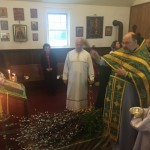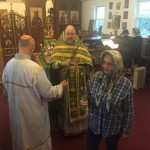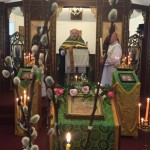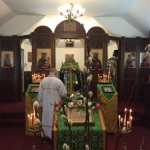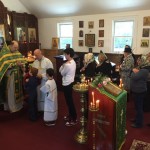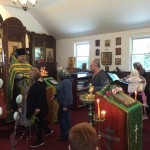On April 24, on Palm Sunday we had a solemn celebration of the feast of the Entry of our Lord Jesus Christ into Jerusalem. The Rector of St. George Church, Archpriest Igor Tarasov served the Divine Liturgy.
After the reading of the Hours the Rector blessed the pussy-willows and distributed them to the parishioners who were holding them during the service resembling the people of Jerusalem who greeted Jesus Christ with the olive and palm branches during His triumphal entry to the city.
Following the readings from the Scripture Fr. Igor preached a homily in Russian. An English translation of that homily is as follows:
“Today we celebrate Entry of the Lord into Jerusalem, a feast preceding the commemoration of the holy Passions. In fact, yesterday we started this separate calendar period of the Passion week, celebrating Lazarus Saturday, a miracle of resurrection of the dead man, a friend of our Lord whose name was Lazarus. Lazarus died and after four days passing his death our Lord came to the village where Lazarus lived and called him away from the tomb. Today’s celebration continues that theme and today we sing the same troparion which mentions righteous Lazarus resurrected by our Lord. At the end of today’s reading from the holy Gospel of John we also heard that the people of Jerusalem went out to greet Jesus because “they heard that He had done this sign” (Jn. 12, 18). People heard that Jesus raised Lazarus from the dead, so they believed in Him, at least, for some time.”
“We could notice that the miracle of the resurrection is here called “a sign”. This expression is often used in the Gospel to describe some miraculous and important events. This is done because those miracles served as the signs of the true coming of the Messiah, of the Savior. These miraculous events indicated that Jesus Christ was truly the Son of God and the One promised by the Prophets. Every miracle the Lord performed had to show that He is the true Messiah. Thus these were His signs.”
“Signs are important in the life of the people. We use and have them everywhere. The signs tell us about the shop’s working hours, whether it is open or closed. They point us to a right direction. We well know the road signs showing us the way, traffic signs which help us to drive. These are signs used in our regular, earthly life. But also in the spiritual life we use and need signs. The most known religious sign is the sign of the cross which we make many times when we pray. There many other important signs in our holy rites and traditions. For instance, today we bless the pussy-willows, take them and hold. This is a sign, a sign of our allegiance to our Lord. We imitate those people, especially those Hebrew children who came out to greet Jesus when He entered Jerusalem. They held the palm and olive branches which were the signs also, the signs of allegiance and homage. Those people met Jesus as their Lord, their King who entered the holy city with a triumph.”
“We say that the people need the signs. However, the signs by themselves are not solving all the problems. We need to follow them, to obey them or to use them properly. Otherwise they won’t be helpful. If we disregard a stop sign on the road we may have an accident. A similar thing happens with the signs of spiritual nature. Our Lord Jesus Christ performed a lot of miracles before the eyes of the people. He healed the sick, cleaned the lepers, returned the sight to the blind, He even raised the dead, as He did with Lazarus. However, not everyone believed in Him. The Jewish leaders were not persuaded by all those signs. They plotted to kill Him. As the Gospel tells us they still asked Him to show some sign that He is the Messiah, even after He performed all other signs. Jesus answered these people and said: “An evil and adulterous generation seeks after a sign, and no sign will be given to it except the sign of prophet Jonah. For as Jonah was three days in the belly of a great fish, so will the Son of Man be three days and three nights in the heart of the earth” (Mt. 12, 39). Thus, according to the words of Jesus, seeking for a sign may be wrong. The Lord, as we already said, did perform many signs but certain people still did not recognize Him. Therefore, He announced in advance that there will be a sign of prophet Jonah who was three days in the belly of a wale. In a similar way, our Lord was buried for three days before His Resurrection.”
“People in today’s world are very often similar to those leaders of the Jews who failed to believe in Christ and to recognize Him. Many have a very little faith or no faith at all. They seek for the signs. They say, “Show us a sign that God exists”, “Show us a proof that Jesus really lived”. No matter that God shows us a great number of signs every day. Every day we see that the sun is rising. For a person who believes it’s a sign of God’s ruling the world. Every year at spring we see that the flowers bloom, like those pussy-willows we bring today to the church to bless. For a believer it’s a sign of God’s care for the creation. But, of course, for the one who doesn’t believe this is no sign. We may go on and recall that our Lord Himself came to this world and became a fulfillment of the Old Testament prophesies. Everything that happened to Him was foretold by the prophets. However, the leaders of the Jews who knew those prophets did not believe that Jesus was the Messiah. They were still seeking for some sign. And the unbelieving, evil and adulterous generation of our times seeks for a sign, but never finds it. And it never will. Because it does not trust God. It is about them the Gospel says: “Neither they be persuaded though one rise from the dead” (Lk. 16, 31). Most of the scribes and Pharisees did not believe even after Christ Resurrection. And modern unbelievers wouldn’t believe even if one rise from the dead.”
“Today we take those blessed branches and try to resemble the people greeting the Lord, recognizing Him as the Messiah, paying Him homage as our King and the King of kings. Let us really mean that and sincerely name Him our Master and our Lord. Let us trust Him and not demand a sign, for He always gives us enough signs and assurances. Let us be able to recognize them. And seeing them, let us truly recognize our Lord and Savior and praise Him saying: “Hosanna, blessed is He who comes in the name of the Lord!””
After the Liturgy dismissal the Rector and altar servers came before the stand in the middle of the church and performed the rite of glorification before the festal image singing the troparia, kontakion and the magnification of the feast.
Following the glorification the Rector preached a short sermon in English explaining the ideas of his Russian homily. He also reminded the parishioners about our service schedule for the Holy Week and Pascha. The Rector said that we are beginning the Holy Passion Week, a very important and spiritually intense time, and called to attend the services celebrated during that week.
After the service parishioners and the Rector enjoyed delicious meals and interesting conversation during the coffee hour.

